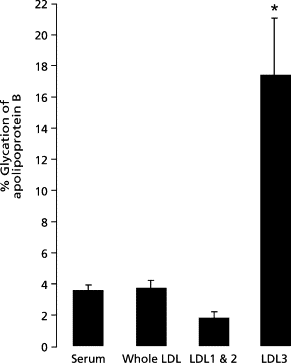Carbohydrates in the diet trigger formation of small LDL particles. Because carbohydrates, such as products made from wheat, increase triglycerides and triglyceride-containing lipoproteins (chylomicrons, chylomicron remnants, VLDL, and IDL), LDL particles (NOT LDL cholesterol) become triglyceride-enriched. Triglyceride-enriched LDL particles are "remodeled" by the enzyme, hepatic lipase, into triglyceride-depleted, small LDL particles.
The list of reasons why small LDL particles are more atherogenic, i.e., plaque-causing, is long:
--Small LDL particles, being smaller, more readily penetrate the endothelial barrier of the arterial wall.
--Small LDL particles are more adherent to glycosaminoglycans in the artery wall.
--Small LDL particles are poorly taken up by the liver LDL receptor, but enthusiastically taken up by macrophage receptors of the sort in your artery walls.
--Because of their poor liver clearance, small LDL persists in the bloodstream far longer than large LDL.
--Small LDL particles are more oxidation-prone. Oxidized LDL are more likely to trigger inflammatory phenomena and be taken up by macrophages in the artery wall.
Let me add another reason why small LDL particles are more likely to cause plaque: They are more likely to undergo glycation. (More on glycation here.)
Glycation occurs when glucose (sugar) molecules in the blood or tissue modify proteins, usually irreversibly. Small LDL particles are uniquely glycation-prone. (This is likely due to a conformational change of the apoprotein B in the small LDL particle, exposing lysine residues along apo B that become glycated.)
Here's a great demonstration of this phenomenon by Younis et al:

"LDL3" is the small type. Note that small LDL particles are 4-5 times more glycated than large LDL. That's a big difference.
Once glycated, small LDL is especially resistant to being taken up by the liver. Like annoying in-laws, they hang around and hang around and . . . The longer they hang around, they more opportunity they have to contribute to plaque formation.
So, carbohydrates trigger formation of small LDL particles. Once formed, small LDL particles are glycated when blood sugar increases. While LDL can be glycated even when blood sugars are in the normal range (90 mg/dl or less), glycation goes berserk when blood sugars go higher, such as a blood sugar of 155 mg/dl after a bowl of steel-cut oatmeal.